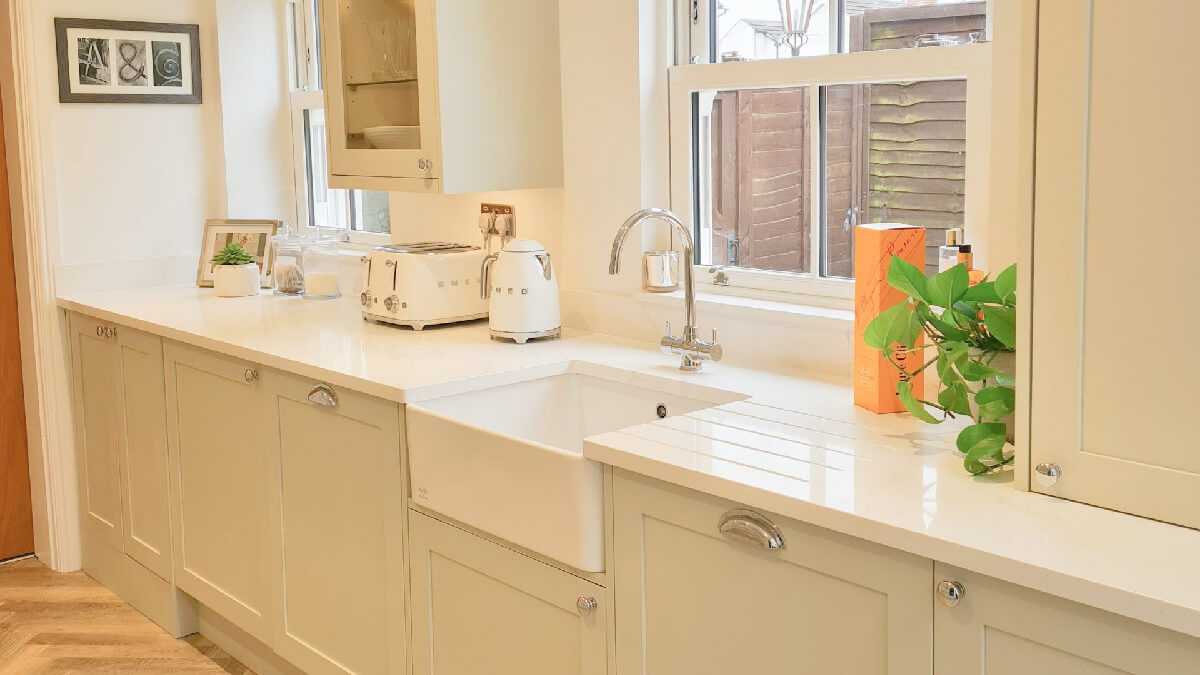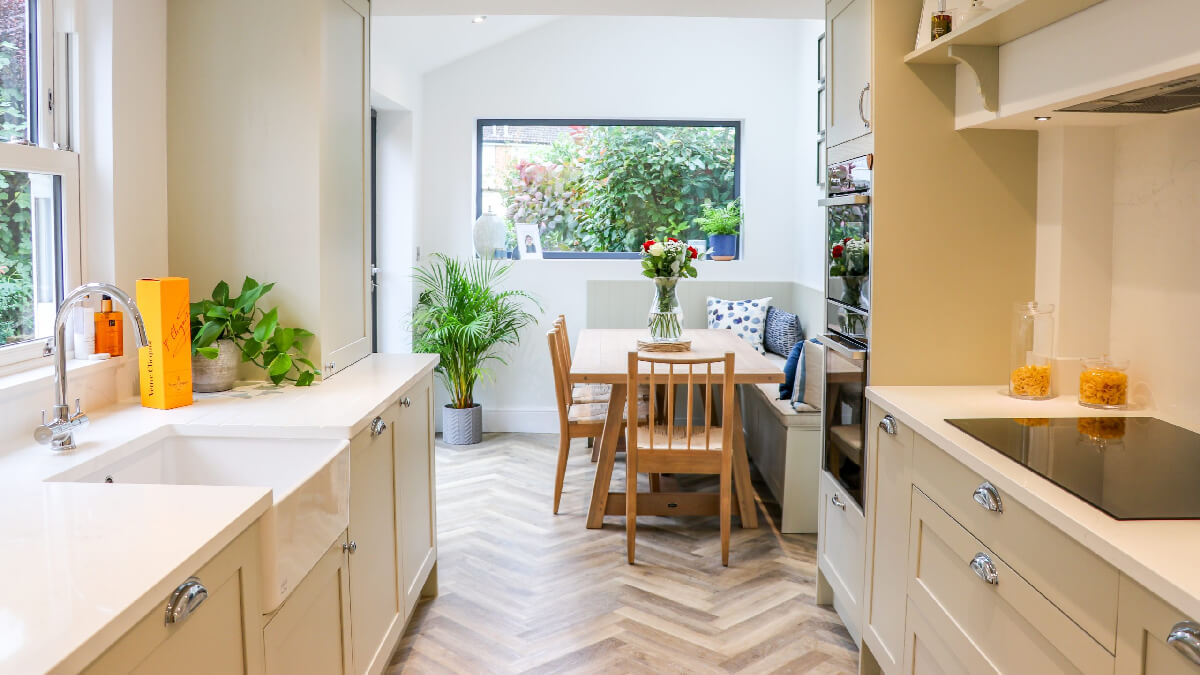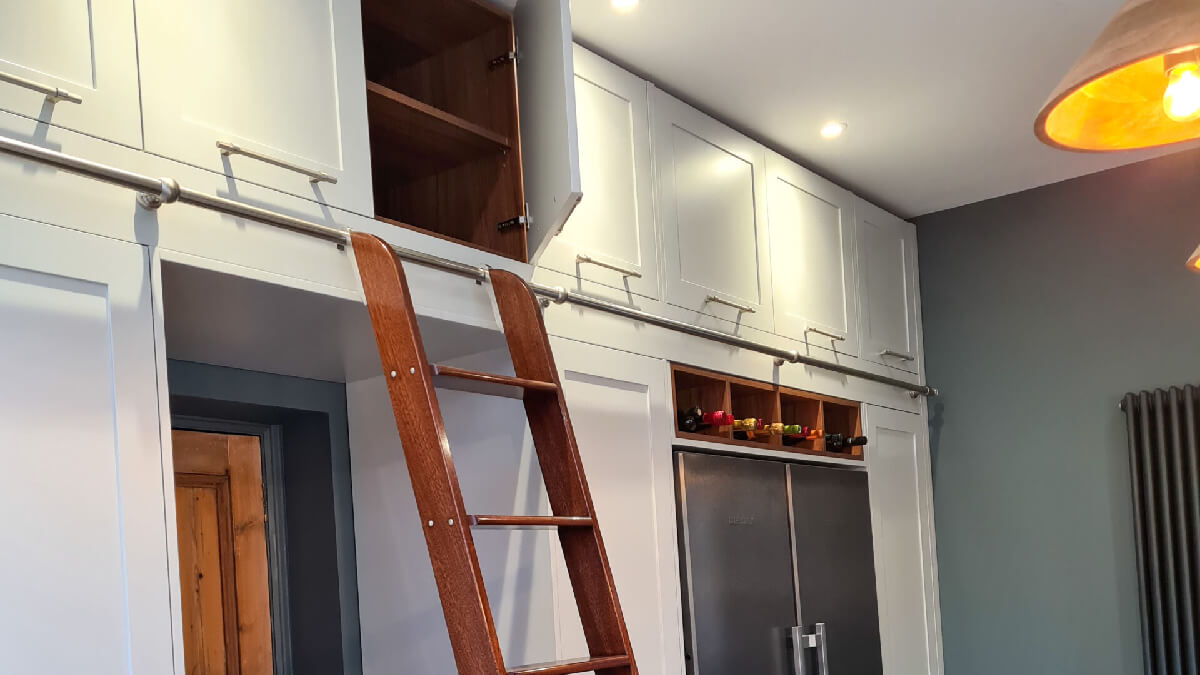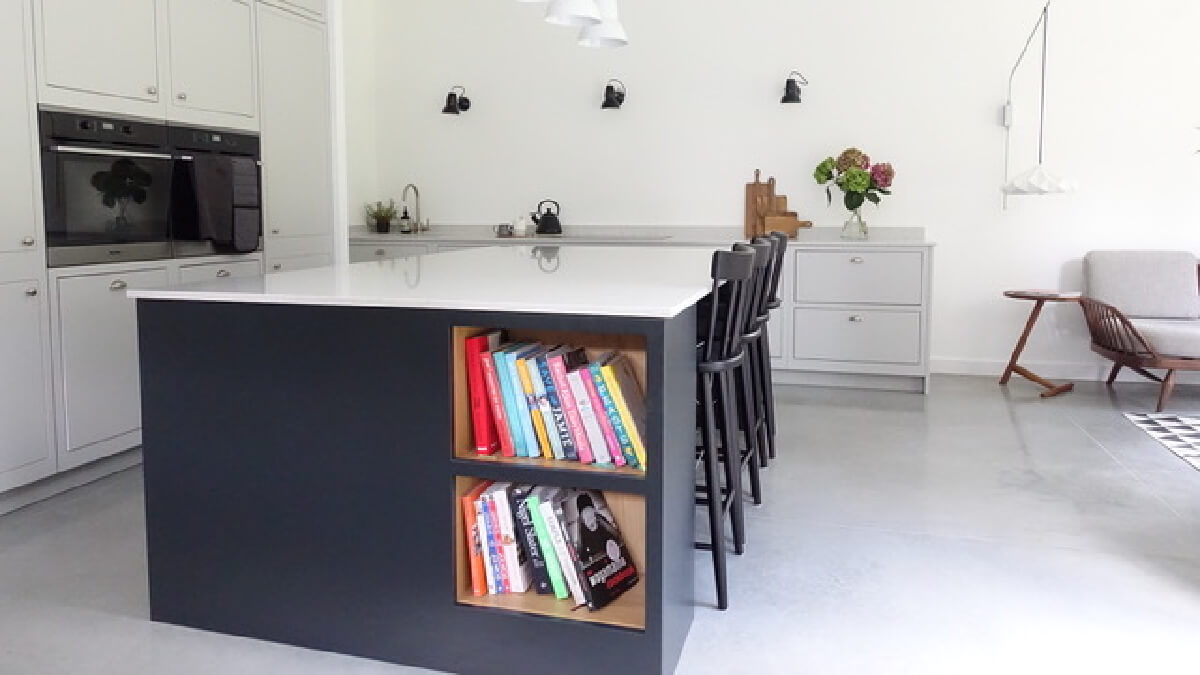No matter what type of house you live in, big or small, old or new, you will most likely agree that the kitchen is one of the most used rooms in your home. Not only does it contain everything needed to prepare your favourite meals, but it’s also a communal area within your household, and the centre of storage and seating. To inspire you, we’ve compiled this article, including 8 of the most popular kitchen styles and how you can create them in your home.
8 popular kitchen styles to consider for your home
Even if the kitchen isn’t something you use frequently, you may find yourself eating, gathering with family and friends, chilling out or even working in there from time to time, so it’s essential that your space can facilitate everything you need it for whilst still feeling comfortable and welcoming.
With years of experience providing homeowners with bespoke kitchens in Milton Keynes, we have explored and created a large variety of kitchen styles, from rustic Moroccan to contemporary industrial designs; there’s something for everyone. Whether it’s the worktops or the cabinetry, there are so many ways to personalise your space – after all, no home is complete without the perfect kitchen. But, which style will be right for you?
- Shaker Style Kitchen
- Country Style Kitchen
- Industrial Style Kitchen
- Victorian Style Kitchen
- Scandinavian Style Kitchen
- Japanese Style Kitchen
- Moroccan Style Kitchen
- Vintage Style Kitchen
In need of more inspiration?
Join our mailing list to see our latest projects, articles and more!
Shaker Style Kitchen
Originating from the Shaker community, a religious group renowned for their craftsmanship and high-quality, handmade furniture, Shaker style kitchen elements feature in many homes worldwide. It all stems from 1821 when the Shaker headquarters published their millennial laws – their goal to create ‘paradise on earth’. These laws restricted the use of decorative features and ensured that everything’s exact purpose and intended placement were always known before anything was made to avoid waste.
Why is it popular?
Shaker furnishings have a simple and minimalist design, with a flat centre panel, straight edges and little detailing. Instead of focusing on the design, all furnishings were built for practicality, utility, function and durability – not for aesthetic purposes. That being said, many may argue that the simplicity and sleekness of the design are very pleasing to the eye and allow the opportunity to accessorise in other areas of the room without the space looking too crowded. If you are looking for a practical kitchen design that uses your space efficiently while still very attractive, this one may be for you!
How can I create this in my home?
Materials
Typically, all shaker furnishings were made from woods local to them at the time and continue to be created with timber such as maple, cherry, pine, chestnut and birch. Using one of these woods, either left natural or painted/stained, is key to creating a shaker kitchen. Our Fitzroy range is one of our favourite shaker kitchens.
Layout
In keeping with the millennial laws, a kitchen island is a must for any shaker kitchen. A traditional way to create more worktop space and extra storage, Shaker style islands make striking, practical centrepieces. A bold colour works excellently to create a statement kitchen island. A critical visual element of a Shaker kitchen is the uniformity of its doors and panelling, so consider hiding integrated appliances such as dishwashers and under-counter bins behind cupboard doors to keep a coherent design throughout.
Colour
Shaker kitchens are known for their primarily natural colour palettes. If you want to stick entirely to the traditional shaker style, a mellow cream or grey would be the best option. However, over the past few years, new colours such as pastels have been slowly creeping into more kitchens, adding a fresh twist and contemporary edge. If you fancy exploring slightly outside the typical expectations of a shaker style kitchen, why not add a bold accent colour throughout?



Country Style Kitchen
The warm and welcoming feeling you can’t help but get when you walk into a country style kitchen is why they refuse to date and look wonderful in any house. Focusing on the use of natural materials and tending to incorporate bursts of colour and pattern, this style is very trendy, and not just in classic country homes.
Why is it popular?
A country style kitchen is the perfect combination of contemporary and traditional; its timeless, classic design can be modernised with up-to-date colours and patterns. The family-oriented functionality works well in any home, and the welcoming, rustic aesthetic makes it the perfect option for someone looking for a kitchen with more of a lived-in appeal.
How can I create this in my home?
Materials
This timeless look can be achieved by combining natural materials and textures such as wood, stone and wicker. The use of lighter woods such as birch or light oak is best, and to get the full country effect, accessorise with different textures and rustic elements. Whether that’s vintage detailing, wool cushions, or some pattern to make your space a bit more fun, the great thing about a country kitchen is how well it can be personalised.
Layout
One important thing to consider when planning the design and layout of your new kitchen is having items on display instead of shut away in a cupboard – country kitchens should appear homely and lived-in and aren’t supposed to be clutter-free. Consider glass front cupboards, floating shelves and free-hanging utensils to get this look. You can even add a pantry area for the ultimate country feel!
Colour
A burst of colour works perfectly with this kitchen style. You can opt for all-over coloured furnishings for a dramatic effect, or if this is not for you, a mellow colour with a bold accent to accessorise compliments the country style significantly. Check out these stunning ideas from Country Living for some inspiration!



Industrial Style Kitchen
A mixture of exposed elements, raw styling and contemporary decor underlines an industrial kitchen. Ideal for large, open spaces, this edgy aesthetic has grown increasingly popular in recent years. The style is achieved by layering a variety of materials together to create contrast and dimension. If you desire something a little more out there, an industrial kitchen perfectly balances sleek and edgy.
Why is it popular?
Industrial kitchens have grown extremely popular recently due to their professional look, understated design and the power they have to make a big, open space feel fresh and modern. Not only this, but industrial kitchens tend to be made from high-quality products, such as stainless steel and brass, that are made to last, extremely durable and easy to clean. So not only is this kitchen style very aesthetically pleasing, but it’s also extremely practical.
How can I create this in my home?
Materials
The key to creating a fantastic Industrial kitchen is the materials. For a classic look, utilise the foundations of your home, for example, exposed brickwork and pipes, stone and concrete. This raw appearance of the elements helps to create the urban feel homeowners seek. Use a high-shine metal like brass, copper or stainless steel as an accent colour and warm-toned woods to soften, but be sure to choose your materials carefully and not mix too many to avoid a cluttered look which can be easily done with this style of kitchen.
Layout
Industrial designs focus on practicality and creating a clutter-free space, with the purpose of functionality over aesthetics. Popular for their spacious layouts, these kitchens tend to feature less wall cabinetry and more exposed shelving to highlight the walls’ natural elements. Typically, they will include an island for additional workspace and storage.
Colours
Choosing the right colour palette is an essential part of creating your kitchen design. For an industrial kitchen, dark greens and blues with warm-toned metallics go great together, with dark woods to contrast. Layering charcoal shades is a great way to create depth and texture, but if the dark colours aren’t for you, why not try a beige or silver and contrast with a bright accent colour instead? If you need some ideas, this fantastic article from Modish Living explores the best colour schemes for industrial design, or watch this video from Home Design Ideas for inspiration.
Victorian Style Kitchen
Victorian style kitchens are one of the most fun to create, drawing design inspiration from both the dining kitchen and the scullery of traditional Victorian homes – a unique mix of elements that can’t be found anywhere else. They tend to be very detail-oriented and include intricate, decorative cabinetry, reflective of both the luxury lifestyle some would be lucky enough to experience and the true working kitchen of a Victorian home.
Why is it popular?
The quirky yet practical design of a Victorian kitchen significantly contributes to its popularity today, along with the warm and cosy atmosphere. Victorian kitchens comprise many different elements and smaller details and accessories, resulting in a sense of character and individuality that can’t quite be replicated in any other style.
How can I create this in my home?
Materials
In Victorian times, wood was a commonly available material that was easy to scrub clean and didn’t taint their food, and it was for these reasons most work surfaces were made out of timber, such as oak and teak. For an authentic look, accessorise with materials such as wicker or lace, or add some patterned backsplash tiles.
Layout
Many Victorian homes have a particular structure and layout that is important to consider when designing your kitchen; one example of this is the primary workspace being in the centre of the room. Make sure to use design elements that complement the property’s architectural style when designing your kitchen. If you don’t own a Victorian household but still seek the traditional look, that’s okay too. You can achieve this by including key statement pieces inspired by the era, such as a pantry and other freestanding furniture, open shelving or a range cooker. As well as this, you can take inspiration from the scullery and incorporate items such as a butler sink, a wet area or a glass-fronted cabinet.
Colours
Cabinetry in Victorian kitchens is most commonly painted cream or white, with a contrasting dark wood worktop. Blues and teals work great if you would prefer to add a burst of colour to the room, and you can accessorise your kitchen with copper or brass utensils for a genuine feel.



Scandinavian Style Kitchen
Focusing on clean lines, efficiency and simplicity, it is no surprise that a Scandinavian style is a go-to for people seeking a bright and airy atmosphere in their kitchen. Its minimalist aesthetic makes it the perfect style for open-plan designs, creating an effortlessly light and fresh space.
Why is it popular?
Traditionally, Scandinavian kitchens are designed to be light, airy and spacious due to the Nordic winters being so dark and eerie. The bright colours and open design provide contrast and comfort from the outside world, inviting a sense of freshness into their lives and home without creating a cold or uninviting atmosphere. Now, people all over the world take comfort in the Scandinavian style, incorporating elements into their homes to freshen them up and create a welcoming, light-filled space.
How can I create this in my home?
Materials
To create this stunning look in your home, you want to select natural, light, untreated wood like ash or beech, or you could go for painted wood in a light colour. Similar to the Industrial style, you can use metals as an accent to add a bit of edge to your design and for the complete Scandinavian look, finish it off with a chevron patterned light wood flooring.
Layout
Scandinavian design is all about being simple and sleek; remember this when selecting your furnishings. Aim to keep any handles as simple as possible, or even opt for handleless cabinets for a dramatic effect. Another key thing to remember is the importance of storage in this design style; additional storage, such as an island, is essential for keeping a tidy space. Our specialist kitchen fitters in Milton Keynes have developed various storage solutions to help you achieve this, or you could also have a read of our guide on organising kitchen cupboards. Lastly, you must utilise windows and natural light as much as possible, so don’t put up blinds or curtains. If you seek a dramatic transformation, consider installing bi-fold doors to maximise the natural light streaming through your home.
Colour
Stick to bright whites, soft greys and subtle beiges for a minimalist light colour palette to keep the room feeling open, clean and fresh. For a pop of colour, choosing one accent shade and placing it throughout the room is a clever way to integrate colour without taking away from the tidy aesthetic.



Japanese Style Kitchen
Japanese style kitchens have been a solid favourite in interior design for years due to their timeless elegance and versatility. The island’s humid climate and unpredictable weather made wood an ideal building material, as wood beam construction is excellent for resisting earthquakes, typhoons and mould. The coherent use of wooden features and integration of plants and nature throughout Japanese designs create an extremely calming atmosphere, resulting in a state of zen throughout.
Why is it popular?
A Japanese design is extremely popular in homes with smaller, more compact kitchens and with those who don’t want their kitchen to be created purposefully as a space for entertaining guests and will be using it mainly for its functional purposes. The materials and styling are also very calming, so if you are looking to bring peace and tranquillity into your home, then a Japanese style kitchen might be for you.
How can I create this in my home?
Materials
Sticking to light woods and natural colours is very important when designing your Japanese kitchen. Choosing a light wood, like pine, with a visible grain will convey a natural feel throughout your entire design.
Layout
The key to designing a Japanese style kitchen is simplicity and keeping things as minimal as possible. Typically, they have open layouts with minimal furnishings to allow for maximum natural ventilation. Many items in traditional kitchens are adapted in a Japanese kitchen due to the lack of space. For example, sliding screens often replace cupboard doors, suspended shelving is quite common due to lack of wall space, and there is usually a hidden worktop barrier to eliminate the appearance of clutter.
Colours
It goes without saying the ideal colour palette for your Japanese style kitchen will include organic green and brown colours, light wood, earth tones and natural stone. Run these colours throughout your kitchen and the rest of your home consistently for the ultimate zen atmosphere.



Moroccan Style Kitchen
Moroccan design has captured the world’s heart for a long time; its carefree, boho aesthetic never dates and looks wonderful in both contemporary and traditional homes. This eclectic style creates such a cosy atmosphere, something many people seek for their homes.
Why is it popular?
Unlike many other kitchen design styles, Moroccan kitchens tend to incorporate a range of colours, textures, patterns and items, the most popular being geometric patterns and zellige tiles. The layering of these is what creates the distinctive Moroccan style that we all know and love today.
How can I create this in my home?
Materials
One of the most common elements you will see throughout a Moroccan style kitchen is, of course, tile. Tiles can be used to create patterned flooring, a colourful backsplash, or inlaid in furnishings, but wherever you add it, it will surely add that Moroccan flair to the room. The detail makes the difference in Moroccan designs – delicate, hand-carved elements are perfect for this aesthetic, along with Persian and woven rugs, metalwork designs and tapestries. Avoid excessive use of synthetic materials and instead opt for natural resources with texture, such as light wood, concrete and stone, to keep the authentic feel throughout your kitchen.
Layout
Freestanding furniture is key to completing the Moroccan look; whether that’s a table, cabinet or drawer, not everything should look like it was built to fit perfectly. After all, the mismatch effect is what makes this style so unique. Shaker style cabinets go nicely in Moroccan kitchens, but individual shelves are also a great feature to include and allow the opportunity to display your favourite Moroccan glasses and plates! If you have the space available, pouffes, sofas, cushions, and ottomans are a great addition to create a small lounging area for comfort. Moroccan Bazaar provides exquisite hand-crafted Moroccan furnishings and lighting, that would add an authentic touch to your kitchen.
Colours
When selecting the colour palette for your kitchen, we recommend you stick to rich, jewel colours like emerald green, ruby red and royal blue. Pair these with a fresh white to create contrast and depth. Alternatively, you could opt for earthy tones or a rusty orange, whichever suits you best.



Vintage Style Kitchen
By incorporating various items, materials and details, a vintage style kitchen offers a wide range of aesthetics, making it a versatile style that is as much at home in a country kitchen as it is in a city apartment.
Why is it popular?
The vintage design allows you to express your personality through your decor and create a comfortable home environment that instantly feels representative of your character. Not only that, but buying pre-loved items is a highly sustainable way to design and decorate your home whilst still achieving your desired effect. Vintage kitchens also create a ‘lived-in’ feel, transforming your house into a home.
How can I create this in my home?
Materials
When considering flooring, tile and terracotta are both timeless classic options. Using heritage-inspired textiles throughout your design will ensure your kitchen has that authentic, retro feel. Lace, floral and plaid fabrics are great examples of this; you can use them on cushions, curtains or blinds.
Layout
The layout of a vintage kitchen plays a significant role in the overall design. The idea is that everything is a bit mismatched and random, which is what ultimately creates the vintage aesthetic; adding freestanding furniture like a pantry, some drawers, a round dining table or a range cooker will help to achieve this. Shaker style cabinets look great in vintage kitchens, but why not swap a couple out for glass-fronted cupboards for a dated effect?
Colour
Pastel colours are extremely popular in vintage design, allowing you to add large block amounts of colour without overpowering the room. Something else you can do that you can’t do with many other design styles is experiment with wallpaper – floral prints tend to be favoured. Be careful not to choose something too dominant when selecting your wallpaper, but the right choice can completely make your space.



Which popular kitchen style suits you best?
Have any of the above given you inspiration for your own home? There are lots of different directions to take your design and many ways to make it personal to you and your home. If you are looking to transform your kitchen and would like a helping hand with your kitchen design, then please feel free to contact our team or come and visit our Kitchen showroom in Milton Keynes for more inspiration.
Book today to start planning your renovation!
Please leave your details below to speak with one of our experts.
